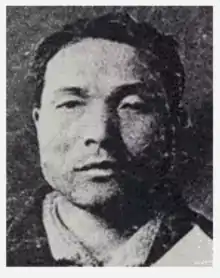Yoshie Shiratori
Yoshie Shiratori (白鳥 由栄, Shiratori Yoshie, July 31, 1907 – February 24, 1979 (age 71))[1] was a Japanese national born in Aomori Prefecture. Shiratori, who became an anti-hero in Japanese culture, is famous for having escaped from prison four times.[2] A memorial to Shiratori is in the Abashiri Prison Museum.


There are numerous tales involving his escapes, though some of the details surrounded them can be said to be folkloric rather than factual.[3]
Prison breaks
Yoshie's worked in a tofu shop initially and later worked as a fisherman to catch crabs for Russia. After changing failed businesses several times, he became known for addictive gambling and stealing.[4]
First prison break
Yoshie was transferred to Aomori prison in 1936 and escaped by lockpicking and studying the guards routine for months after 15 minutes.[5][6]
Second prison break
Police recaptured him after three days while stealing supplies from a hospital. He was sentenced to life in prison for escaping and stealing. He was transferred to Akita prison in 1942.[6]
At Akita prison, Yoshie escaped by climbing the walls of his cell through the sky light. He is said to climb up every night to unhinge the vent. He was captured again soon.[5]
Final years
After a year of liberty, it was said that Yoshie was offered a cigarette by a police officer in a park. Moved by the kindness, Yoshie admitted that he was an escaped convict and offered to be turned in by the officer. He was tried once again. The High Court of Sapporo revoked the previous decision of the death penalty and sentenced him for 20 years in prison. Yoshie's request to be imprisoned in Tokyo was also granted. He spent his days in Fuchu Prison until 1961, 14 years later, due to good behavior, he was released.[7][6]
Later, he went to the Aomori to reunite with his daughter so that he could tell her his life story. Yoshie lived for another decade doing odd jobs to survive. He eventually died of a heart attack in 1979, aged 71.[5][6]
In media
Akira Yoshimura's novel Hagoku was based on Shiratori's life.
The character Yoshitake Shiraishi in the manga Golden Kamuy by Satoru Noda was revealed in an interview with the author to have been based on and named after Shiratori.
References
- "白鳥由栄の写真、名言、年表、子孫を徹底紹介". 昭和ガイド. Retrieved 2020-12-08.
- Schreiber, Mark (5 May 2018). "News outlets quick to fall in love with prison break coverage". The Japan Times. Retrieved 29 December 2019.
- "漫画『ゴールデンカムイ』の脱獄王に実在モデルがいるって知ってた?(齋藤 海仁) @gendai_biz". 現代ビジネス. Retrieved 2020-12-08.
- "The Unbelievable Prison Break (Part 1)". ARTICLE MENU. Retrieved 2020-12-08.
- Jr, Marius Carlos (2020-02-03). "Yoshie Shiratori: The Incredible Story of a Man No Prison Could Hold". Breaking Asia. Retrieved 2020-12-08.
- author (2016-06-30). "昭和行刑史に残る脱獄王・白鳥由栄の人生". アナブレ. Retrieved 2020-12-08.
- "Top Ten Prison Escapes of all Time". Oxford Castle & Prison. 2015-07-21. Retrieved 2020-12-08.
External links
- Hagoku from Charm of Hokkaido
- (in Japanese) Yoshie Shiratori from MONSTERS
- Abashiri Museum website